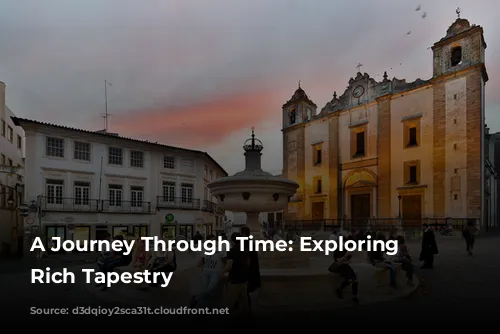Évora, a charming town nestled amidst the cork groves of Portugal’s Alentejo region, boasts a history as rich and diverse as its captivating landscape. From the days of the Romans to the rule of the Moors and the reign of Portuguese kings, this proud little town has witnessed centuries unfold. Just a short drive east of Lisbon, Évora beckons travelers with its captivating blend of historical landmarks, relaxed ambiance, and delectable cuisine.
A Timeline of Triumph and Transformation
Évora’s story is a tapestry woven with threads of different cultures and eras. In the second century BC, it thrived as a Roman town, its prosperity fueled by wheat and silver and its strategic location on a trade route to Rome. The Moors held sway from the eighth to the 12th century, leaving their mark on the town’s architecture and cultural fabric. During the Renaissance, Évora became a favored destination of Portuguese kings, reaching its peak of power under the reign of King João III. His legacy is still evident in the town’s grandeur and architectural splendor.
The Heart of Évora: Praça do Giraldo
Évora’s walled city is a delight to explore. Its main attractions are clustered within a short walk of Praça do Giraldo, a vibrant square that serves as the beating heart of the town. This historic square, named after Giraldo the Fearless, the Christian knight who liberated Évora from the Moors, was once the bustling marketplace during the Moorish era. Today, it remains a lively hub, attracting locals and visitors alike for its lively atmosphere and bustling commerce.
Cobbled Streets and Local Charm
Radiating from Praça do Giraldo, cobblestone streets, protected by law and adorned with traditional decorations, invite you to wander and discover the hidden gems of Évora. The streets are lined with charming shops selling a vibrant array of local products, from cork crafted into exquisite purses and postcards to tilework, leather goods, ironwork, and the distinctive Arraiolos rugs woven in a nearby town. The yellow hues of many buildings, a common trait in the Alentejo region, are believed to ward off evil spirits, adding a touch of mystique to the ambiance. Jacaranda trees, imported from South America two centuries ago, cast their shade during the summer, their purple blossoms adding a burst of color in the spring.
Echoes of the Roman Empire
Remnants of the Roman wall that once encircled Évora can be seen scattered throughout the town. However, the most impressive Roman ruin lies atop a hill, commanding breathtaking views of the surrounding landscape. Fourteen Corinthian columns stand as a testament to the majestic Roman temple that once graced this site. Today, the evocative temple backdrop hosts open-air concerts and events, its beauty enhanced by floodlighting at night.
A Fusion of History and Art: The Museum of Évora
The Museum of Évora, situated where the Roman forum once thrived, offers a fascinating glimpse into the town’s rich history. The museum’s courtyard houses an excavated section of the forum, surrounded by an eclectic collection of Roman artifacts, medieval statuary, and 16th-century Portuguese, Flemish, Italian, and Spanish paintings. This captivating blend of historical treasures and artistic masterpieces transports visitors through centuries of cultural evolution.
Évora’s Cathedral: A Blend of Architectural Styles
Ascending the hill alongside the museum stands Évora’s cathedral, a magnificent structure that blends Romanesque and Gothic architectural styles. Built on the site of a former mosque, the cathedral houses a 15th-century marble statue of a pregnant Mary, a deeply revered figure in the Alentejo region. Across the aisle, a Renaissance Gabriel, added a century later, brings the story of the Annunciation to life. For breathtaking panoramas of the surrounding plains, climb to the cathedral’s rooftop terrace, where the view is as awe-inspiring as the cathedral itself.
The Church of St. Francis: A Meditation on Mortality
While Évora’s cathedral commands attention, the Church of St. Francis, built in the 14th century by the Franciscans, holds a unique appeal. The highlight of this intimate church is its Chapel of Bones, where thousands of human bones adorn the walls, a poignant reminder of the impermanence of life. The chapel, a creation of three monks who sought to inspire meditation on the transcience of material possessions, serves as a powerful reminder of mortality. The inscription above the chapel door, “We bones in here wait for yours to join us,” is a stark yet thought-provoking message.
A Slice of Local Life: Farmers Markets and Delectable Cuisine
After contemplating the passage of time, return to the bustling heart of Évora and immerse yourself in the vibrancy of local life. Visit the farmers market, where the air is filled with the aroma of fresh seafood, the vibrant colors of local produce, and the inviting scents of traditional cuisine. Grab a picnic lunch and relax in the public garden next to the church, or savor a queijada, a beloved local pastry, from the kiosk café within the park.
A Night in Évora: Savor the Alentejo’s Rustic Charm
While a day trip from Lisbon can provide a taste of Évora’s wonders, staying overnight allows you to truly savor the town’s unique character. Indulge in the Alentejo region’s rustic cuisine, characterized by hearty dishes featuring game and paired with robust red wines. As the evening descends, stroll through the charming backstreets, absorbing the relaxed ambiance of this quintessential Portuguese town. Embrace the opportunity to experience the simple pleasures of a working-class town, far removed from the hustle and bustle of the city.
A Journey Through History, Culture, and Flavor
Évora, a town steeped in history, culture, and culinary delights, is a testament to the enduring legacy of Portugal. From its Roman roots to its Moorish past and its Renaissance grandeur, this charming town offers a captivating journey through time. Whether you’re captivated by historical landmarks, charmed by cobblestone streets, or enchanted by local traditions, Évora offers an unforgettable experience.
